What is brand equity? Why does it matter?
What comes to mind when you visualize golden arches, a bitten apple, or the silhouette of a castle? Most likely, you are now thinking about some iconic brands and companies. Digging deeper, did you feel positive emotions? Negative emotions? Did you reminisce about a personal memory or experience with these brands?
At a minimum, you probably have an opinion about each of these brands – what they stand for, what they don’t, how they’re different from their peers – and perhaps most importantly, if you would pay for their products.
These associations, feelings, and opinions that you have for these brands are at the core of what “brand equity” attempts to define. Brand equity reflects consumers’ attitudes toward a brand. These attitudes are critical for brands to monitor, because the more positive the sentiment (i.e., the stronger the brand equity), the more the consumer is predisposed to:
– Consider the brand
– Buy more of the brand
– Buy with less reminding
– Pay a premium
– Advocate for the brand to others
– Be less influenced by competitor products and advertising
As companies increasingly invest in performance marketing in recent years to drive sales, brand equity is sometimes a secondary priority or even neglected. Eventually, this can backfire. This is because brand equity is not about discounts or promotions. It is about ensuring that consumers have your brand top of mind and associate it with positive experiences and emotions. When consumers think favorably about a company, they will consider it first when a need arises and purchase its products even in the absence of discounts or promotions. This means that brand strength is crucial to sales and profits, both today and in the future.
Brand equity is not just a theoretical concept. Kantar’s BrandZ study, which tracks and values 18,000 brands in 50 markets across 4 million consumer respondents, finds that stronger brands generate greater shareholder returns, are more resilient in times of crisis, and recover more quickly.
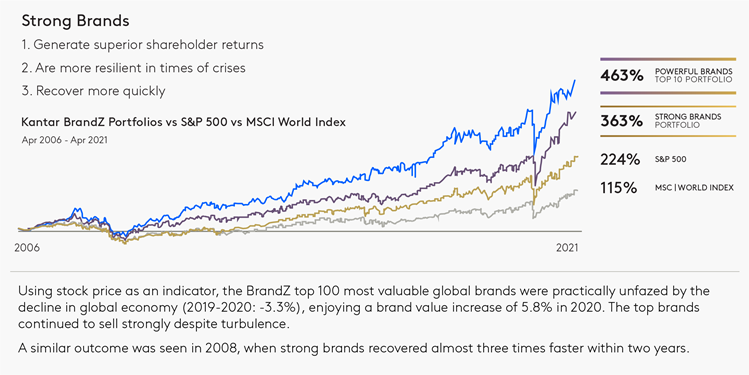
How can I build my brand’s equity? Can I build my brand equity through advertising?
Before we can successfully build brand equity, we must first understand how to measure and track it. At Kantar, we break down brand equity into three key factors: Meaningful, Different, and Salient. In layman’s terms, does the brand meet consumers’ needs and emotionally connect with them (i.e., what is the meaning that a consumer ascribes to a brand)? Is the brand unique and differentiated in its category? And finally, does the brand come to mind quickly in a purchase situation?
Brand-building, then, is the long-term strategy for building, maintaining, or changing brand equity and its components and will yield outcomes such as growing or sustaining sales and market share, or shifting brand messaging and positioning.
By breaking down brand equity into distinct components, we can focus on the specific elements to improve for each brand’s unique position in the market. For instance, if a brand has a meaningful connection with consumers and is differentiated, but is not widely known, then we can undertake activities that promote saliency and awareness. Marketing is the natural vehicle for enhancing salience.
Marketing can also drive more than just salience. This is because you don’t need to have had a personal experience with a brand or its products to have an opinion about it. People create a series of associations between thoughts, feelings, facts, and anecdotes, and the cumulative sum of this represents their predisposition toward a brand. Naturally, some of these associations are informed through personal experiences. But in today’s information age with a countless number of brands, consumers rely more on a brand or product’s distinctive assets – verbal, visual, or auditory, to trigger an instant recognition that serves as a heuristic to brand meaning.
In practical terms, even if you have never visited Disney World, you probably have a mental visual (likely from marketing materials!) that the resort features smiling children and Disney characters in a fantastical setting. Just from this alone, you get a sense of the meaning of the product and how it is different from other resorts, such as Universal Studios. This example illustrates how marketing can highlight and educate consumers on a brand’s difference and meaning.
Marketing can drive all facets of brand equity even as it drives sales in the short-term. An analysis of Kantar’s marketing mix modeling database finds that while media investment directly contributes to about 13% of sales across the brands studied, this contribution increases to 28% when media’s impact on long-term brand equity is included.

To better understand the specifics of how marketing drives brand equity, Kantar partnered with Meta to study the relationship between marketing and brand equity for global leaders across a variety of industries. The brands in this case study rely on a broad media mix, including Meta, to grow and support their brand performance. This paper will tie in broader learnings and data points from WARC and Kantar and examine how marketers can optimize their use of Meta technologies to achieve this brand-building goal.
A lot of marketers rely on Meta technologies to drive sales and build their brands. Given its reach and maturity, we can understand why. In Kantar’s database of over 1,200 Kantar CrossMedia campaigns globally, Facebook is a cost-effective brand-building channel, contributing to brand objectives such as awareness, associations, or purchase
motivation.
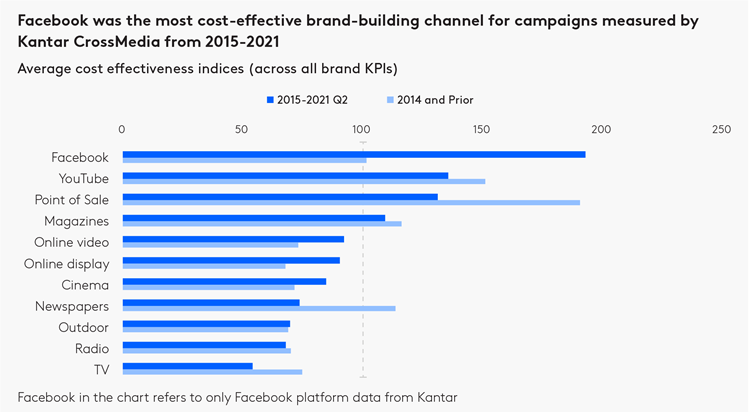
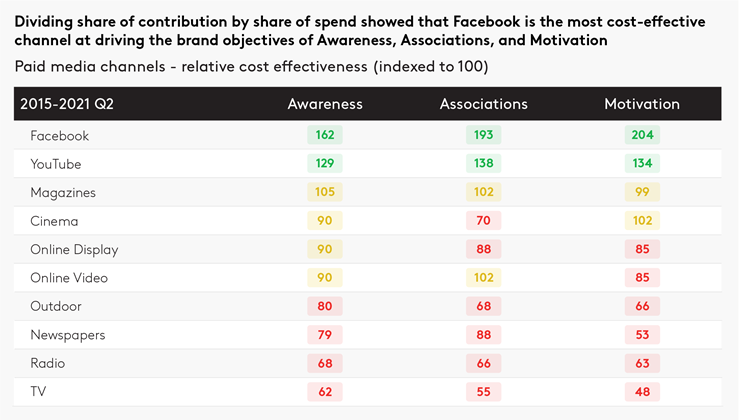
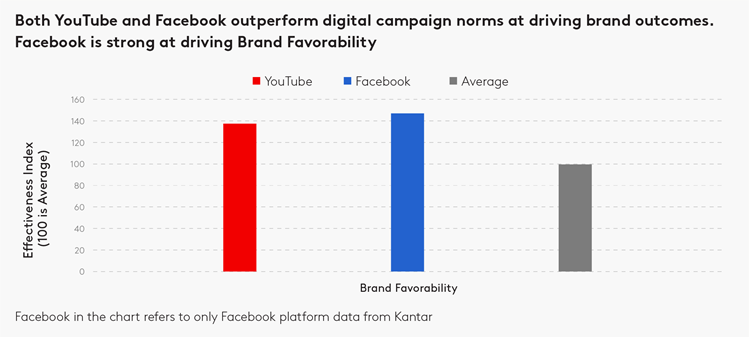
These factors mean that marketers can benefit greatly through optimizing brand - building efforts using Meta technologies.
In this case study, we analyzed how marketing and advertising across Meta technologies drove key components of brand equity for the brands studied, including salience and meaning-related consideration measures.
We found clear relationships between media investment and brand equity across all brands studied. Meta advertising had a measurable impact on brand equity across all brands despite differences in industry and marketing strategies. Meta advertising also contributed to brand equity efficiently, delivering 34% more than its fair share of contribution to equity metrics vs its investment level.
From these studies, we identified the five key learnings below for marketers to consider when brand-building using Meta technologies.
How can marketers optimize their media investment for brand-building when advertising on Meta? 5 learnings
1. Use all placements, and align placements and creatives with brand-building objectives
Meta has Facebook and Instagram as platforms for advertisers, with each offering different placements for ads. These platforms and placements have different layouts and considerations. Therefore, creative customization per each platform’s strengths is key to maximize impact.
In our studies, we found that all the different placements across Facebook and Instagram worked to drive brand metrics, giving marketers flexibility in their brand building approach. Leverage all placements available to efficiently make meaningful connections with consumers.
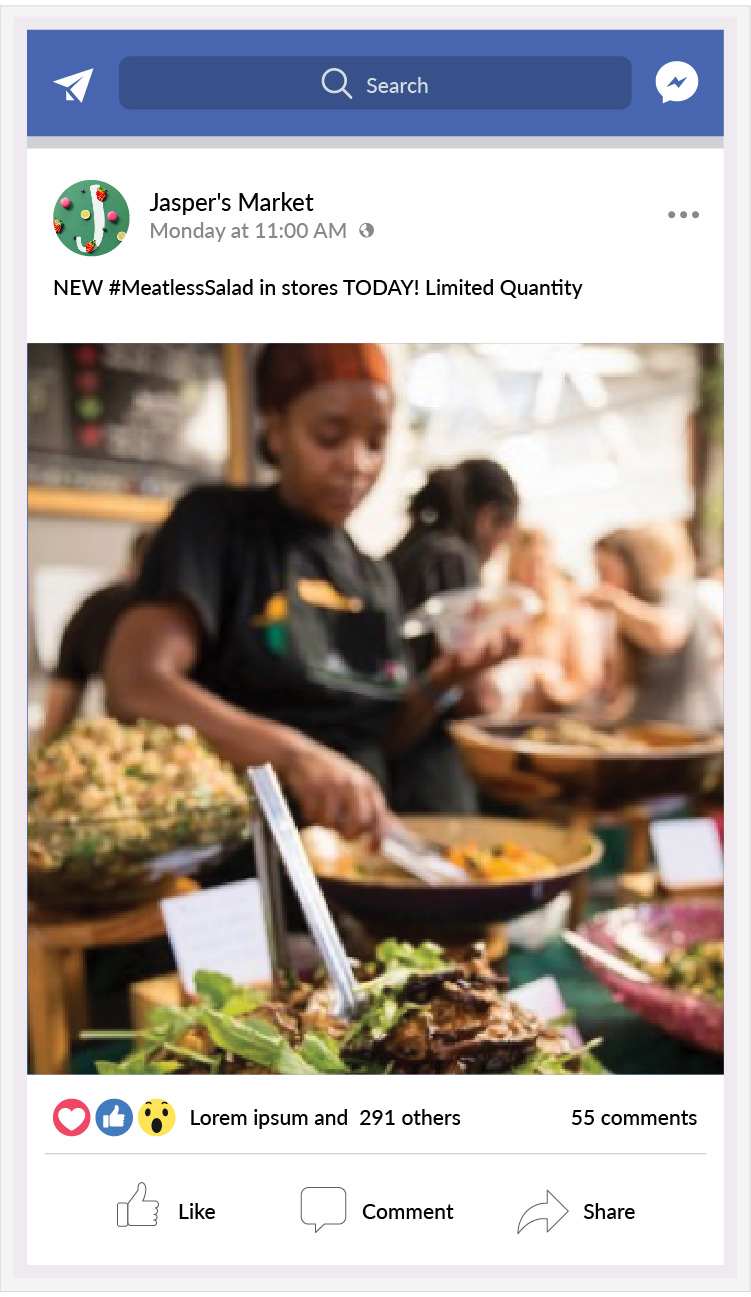
Facebook
Kantar's media learnings indicate that on Facebook, you need to grab attention – this can be done by showing unexpected situations. If there are captions, ensure they set suitable expectations. The messaging should be short and simple. The creative concept or messaging should also not rely on audio.
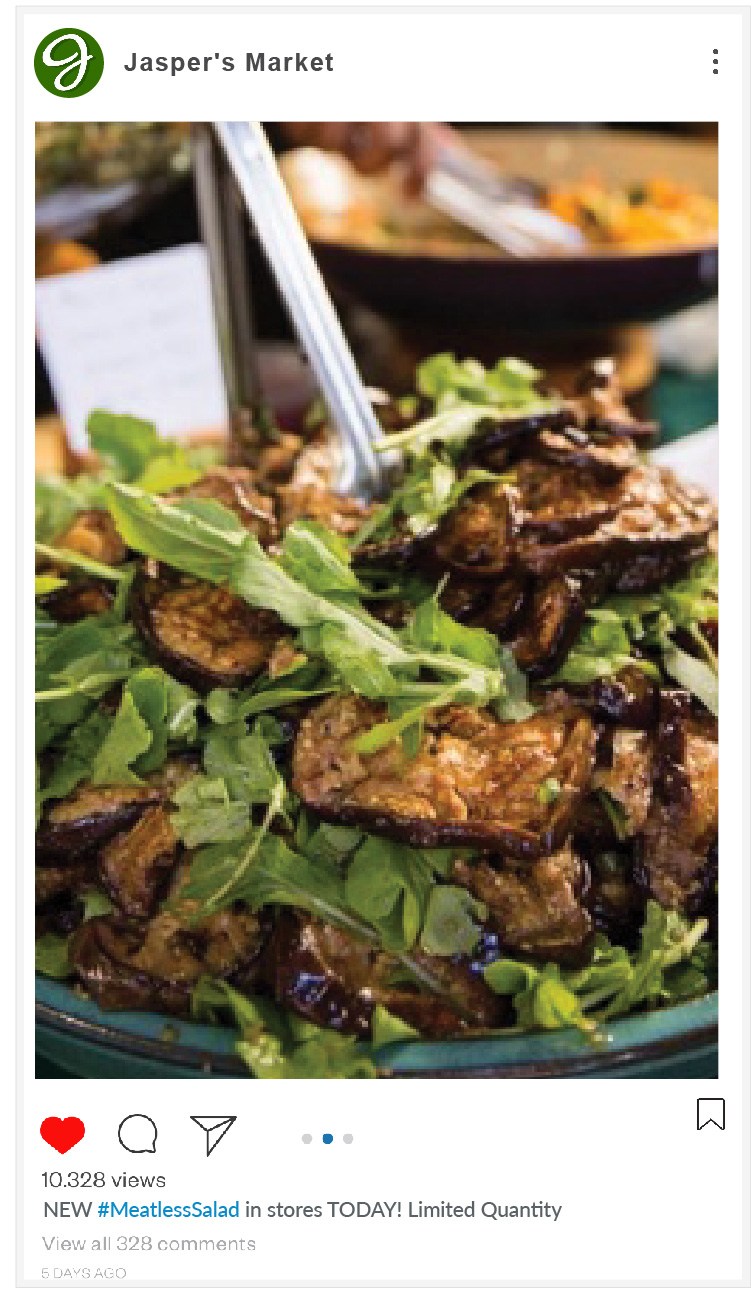
Instagram
All of the placements available on instagram should be used. Instagram feed differs from Facebook in that Facebook has a headline while Instagram doesn’t. This is important when considering if the headline is playing a key role for the creative or campaign.
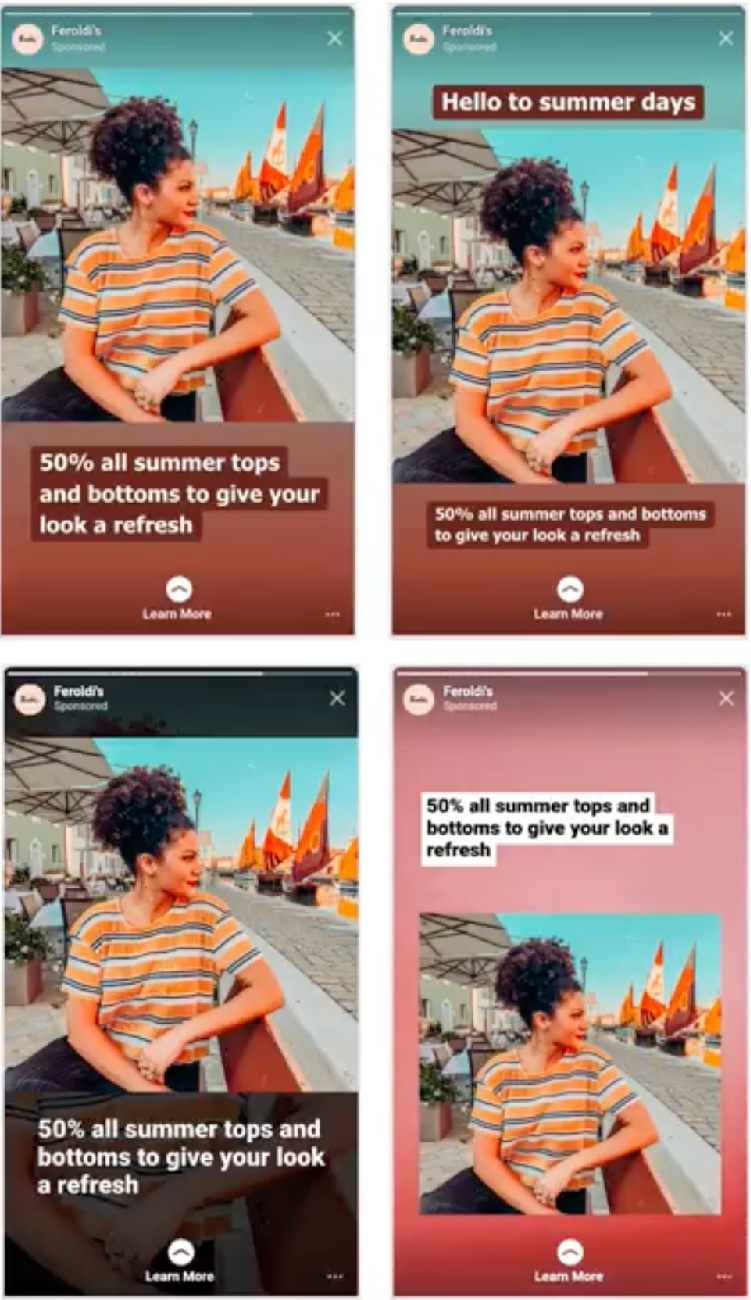
Stories & Reels
Adapt content for these unique properties. For instance, Story ads are in a 9:16 aspect ratio, which leads to the left and right of a standard Facebook ad being cropped. There is also no text copy for users to read, so you should consider visually conveying any supplemental information.
2. Brand-focused advertising works best for brand-building objectives, but Direct Response can still work to build brand
You may already be having great success at driving your customers to undertake an action (Click here for this offer! Buy now!). We found that this type of Direct Response advertising can still help to build your brand KPIs while driving short-term sales.
But to truly maximize your brand-building efforts and form that brand love in the mind of your consumers, leverage brand-focused creatives. In our studies, upper-funnel focused ads are 1.6x more efficient than lower-funnel at driving long-term brand metrics.
It is important to have a balance of brand-building ads with lower-funnel ones. Les Binet and Peter Field, renowned researchers in contemporary ad effectiveness, found that in general, the optimum split of marketing investment between short-term DR and long-term brand building is 40% and 60%, respectively. This can vary by sector and by context – for instance, strong brands are especially important in sectors where activation is the norm, such as travel2.
3. Video works better than static but don’t make them longer than needed
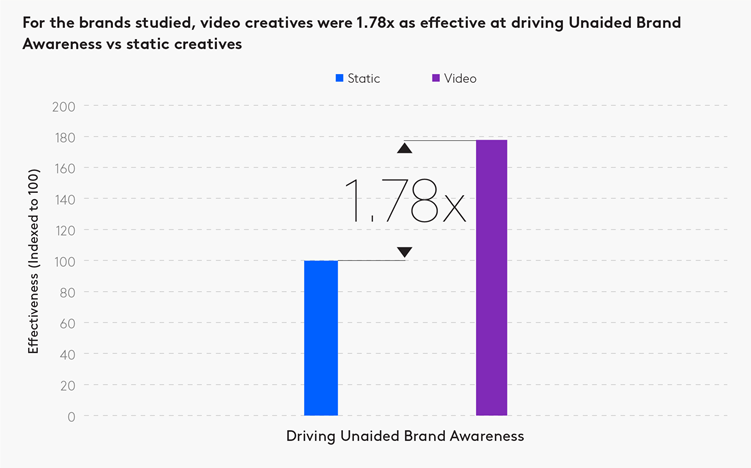
Our analysis across the multiple brand equity KPIs of these diverse brands found that video creatives worked harder than static creatives for brand-building. While this may seem intuitive, you may be surprised at our finding that shorter video length tended to be more effective than their longer-length counterparts. Consumers have shorter attention spans than ever before and we see this phenomenon reflected in our meta-analysis of Kantar’s Link database for digital videos, which showed a drop-off in the average percentage of ad viewed as ad length increased. Therefore, it is important to have strong branding from the onset of the ad.
4. More reach is a good thing
Building brand awareness starts with casting a wide net. You can have the most compelling and creative campaign in the world, but if that campaign is not seen by enough people, or the right people, it is likely to be ineffective.
Today, advertising platforms and tools are more sophisticated than ever and allow for hyper-specific targeting of consumers. This precise targeting can improve marketing efficiency when it comes to conversion, but remember that a core tenant of brand-building is salience - your brand needs to come to mind when a purchasing decision is being made. From a brand-building perspective, having more people exposed to your brand is beneficial as you may tap into valuable consumer groups that were not previously considered. This is why more reach is a good thing.
Meta leads the digital market in this respect, with a reach of nearly 2 billion DAUs3 just on Facebook alone. In our own CrossMedia database, we find that Meta has grown over the last few years to become the leading channel by average reach, just after TV (which has declined over the same period).
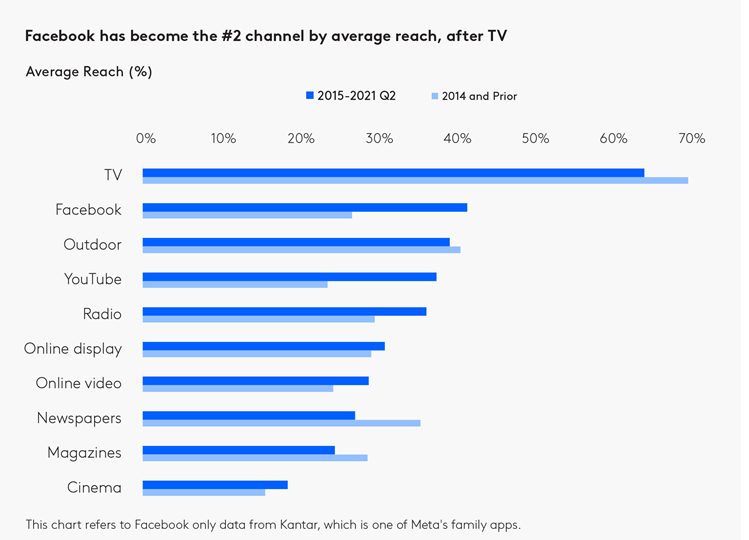
Despite their established positions as industry leaders in their respective fields, all the brands studied could have increased their marketing reach significantly before approaching saturation levels. Don’t underestimate the benefits of reaching a wider audience, especially when the objective is brand-building.
5. Higher frequency may be needed for Brand Building vs driving an action with DR
Across our studies, we found that three exposures per week on Meta was the optimal frequency for driving brand awareness. This frequency may be higher than what is needed to drive short-term sales. This may be due to the brand-focused creatives not necessarily having a call to action.
We see this in a meta-analysis of our global Kantar Marketnorms Brand Lift database, where higher exposure frequencies lead to increased brand impact across dimensions like Aided Brand Awareness, Message Association, Brand Favorability, and Purchase Intent.
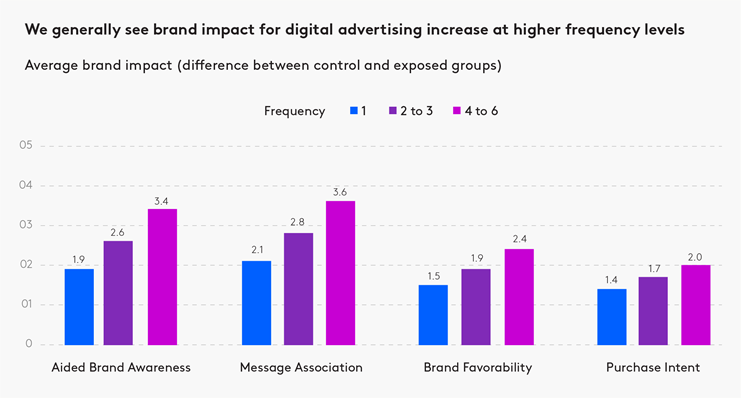
Wrap Up
Brand-building takes focus, consistency, and time.
An organization should be aligned from top to bottom on its core brand tenets before developing a communication strategy around them. The marketing creatives and campaigns should also be in sync with the strategy and make sense for the channels they are executed on.
Not only does a brand’s messaging need to be consistent, but its actions as well. As famed investor Warren Buffet once said, “It takes 20 years to build a reputation and five minutes to ruin it.” Thankfully, we can build a brand much faster in today’s age with the unparalleled reach and hyper-focused targeting capabilities that advertising platforms provide. We can track, measure, and optimize investments to maximize brand-building, as outlined here.
Still, brand love cannot be built overnight. Brand KPIs move slowly, especially for larger, more established brands. Remember, having a brand-building focus doesn’t mean foregoing sales in the short-term. As we’ve shown, brand-building investment can drive sales today while building brand strength for the future.
When done correctly, investment in brand-building can pay off several fold, especially during downturns. All businesses encounter turbulence – none are immune – but stronger brands have the wings that allow them to fly through storms and soar to new heights beyond.
1 Meta technologies refer to all or a subset of Meta’s apps (Facebook, Messenger, Instagram, WhatsApp, etc.)
2 WARC. Anatomy of Effectiveness.
3 Facebook 2022 Q3 Financial Report
